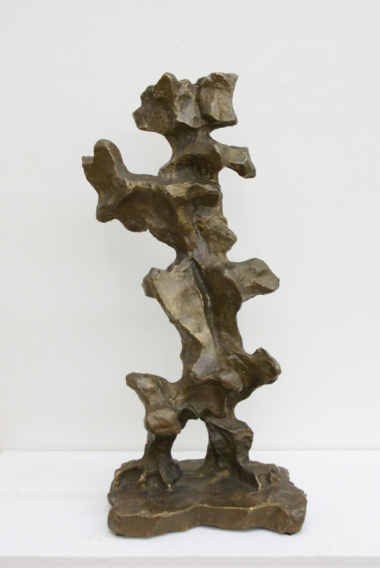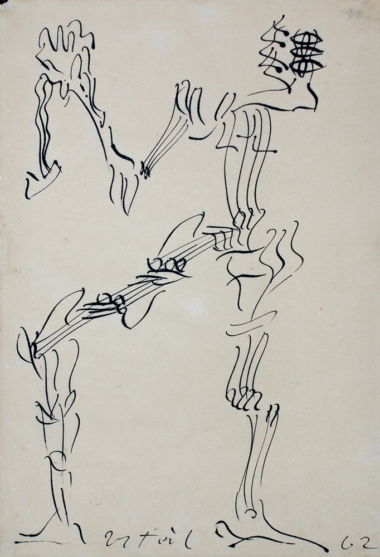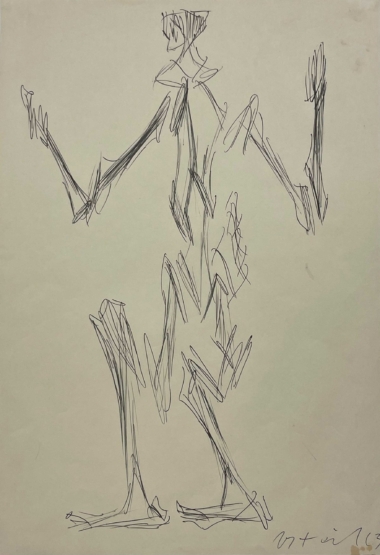Andreas URTEIL was born on 19 January 1933 in Gakovo, in the former Yugoslavia. In 1945 he was interned with his mother and brother in a Yugoslav prison camp. In 1946 they managed to escape via Hungary to Vienna. From 1947 Urteil completed an apprenticeship as a stonemason and attended art classes at the Volkshochschule. After passing his journeyman’s examination in 1951, he began studying sculpture at the Academy of Fine Arts in Vienna, taking a master class with Fritz Wotruba from 1953 to 1954. From the 1950s onwards, the artist undertook extended study trips to Italy and studied the art of the Renaissance and Classical Antiquity. In the late 1950s Urteil began to create his spontaneous “Imaginary Figurations”. He destroyed many of his early works and developed his own style. In 1955 he received the master school prize and made contact with the artists of the Galerie nächst St. Stephan. In 1960 he was awarded the sponsorship prize of the Theodor Körner Foundation Fund for Science and Art. In 1961 he followed a teaching assignment for stone sculpture in the class of Wotrubas. In the same year, the sculptor is represented with his works at the Biennale de Paris. In 1962 he was awarded the Austrian State Prize for Sculpture. After a serious illness, Andreas Urteil dies in Vienna on 13 June 1963. Urteils works were shown at the documenta III in Kassel in 1964. He was represented with his works at the world exhibitions in New York and Montreal. In 1977 the Andreas-Urteil-Weg was posthumously named after the artist in Vienna Donaustadt. In his short creative period Andreas Urteil has gone through a rapid artistic development. His works are characterized by liveliness and expressiveness. Despite the short creative period, the artist left behind numerous drawings, sculptures and sculptures. 1979 — first exhibition participation, 2006 — first solo exhibition at Galerie Welz.
Andreas URTEIL was born on 19 January 1933 in Gakovo, in the former Yugoslavia. In 1945 he was interned with his mother and brother in a Yugoslav prison camp. In 1946 they managed to escape via Hungary to Vienna. From 1947 Urteil completed an apprenticeship as a stonemason and attended art classes at the Volkshochschule. After passing his journeyman’s examination in 1951, he began studying sculpture at the Academy of Fine Arts in Vienna, taking a master class with Fritz Wotruba from 1953 to 1954. From the 1950s onwards, the artist undertook extended study trips to Italy and studied the art of the Renaissance and Classical Antiquity. In the late 1950s Urteil began to create his spontaneous “Imaginary Figurations”. He destroyed many of his early works and developed his own style. In 1955 he received the master school prize and made contact with the artists of the Galerie nächst St. Stephan. In 1960 he was awarded the sponsorship prize of the Theodor Körner Foundation Fund for Science and Art. In 1961 he followed a teaching assignment for stone sculpture in the class of Wotrubas. In the same year, the sculptor is represented with his works at the Biennale de Paris. In 1962 he was awarded the Austrian State Prize for Sculpture. After a serious illness, Andreas Urteil dies in Vienna on 13 June 1963. Urteils works were shown at the documenta III in Kassel in 1964. He was represented with his works at the world exhibitions in New York and Montreal. In 1977 the Andreas-Urteil-Weg was posthumously named after the artist in Vienna Donaustadt. In his short creative period Andreas Urteil has gone through a rapid artistic development. His works are characterized by liveliness and expressiveness. Despite the short creative period, the artist left behind numerous drawings, sculptures and sculptures. 1979 — first exhibition participation, 2006 — first solo exhibition at Galerie Welz.










Recent Comments